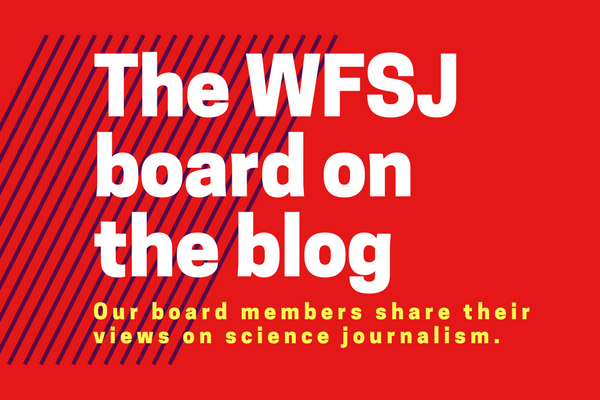
Canadian Board Member and Treasurer, Tim Lougheed, is mind-boggled by the conflict caused by the Internet and social media when writing on science. What’s more, there is an oversharing of preconceived ideas fueled by a stream of images communicating their own little stories. But the medium has also some good things to offer.
For those of us who were writing about science before the Internet was a thing, the discord sown by social media is nothing less than mind-boggling. What was once a trade in ideas and arguments has been supplanted by a whirlwind of images, which give rise to their own sets of ideas and arguments quite independently of any coherent process. This orgy of oversharing regularly generates spats unworthy of a kindergarten sandbox, making a mockery of technology that has suddenly enabled upward of half the planet’s population to exchange billions of messages with one another. And yet this same embarrassing medium can likewise redeem itself with rich intellectual exchanges, linking hearts and minds from all walks of life in ways that we could scarcely have imagined a generation ago.
This conundrum is more than annoying, it has practical consequences. By way of example, consider a dust-up generated by the venerable journal Science, which on the ominous Ides of March published an opinion piece by a University of Toronto doctoral student — Meghan Wright of the Institute of Biomaterials and Biomedical Engineering — who saw fit to critique the social media musings of another University of Toronto doctoral student — Samantha Yammine of the Donnelly Centre for Cellular and Biomolecular Research. Wright bluntly argued that Yammine’s online efforts to represent women in science linger too much on personal detail and consequently detract from the important task of trying to create a level playing field for both genders in the scientific community.
That critique may have merit, but in this case it lost a great deal of credibility by assigning the serious mission of reforming the institutional culture of research to the chaotic information wonderland that is social media. Wright chastises female scientists for Instagram posts of “pretty selfies, fun videos, and microscope images captioned with accessible language and cute emojis.” Apparently exempt from such criticism is Wright’s own Twitter feed that, in addition to detailed updates of her own scientific progress and regular highlights of women’s success in research, includes the prize-winning Millennium Falcon-shaped gingerbread house at her lab’s Christmas party and a bevy of selfies taken after a make-up session.
The point is not that two serious and accomplished academics have populated their social media accounts with some fluff. For better or worse, social media has evolved to accommodate contributions that include brain-dead trivia as well as our deepest musings on life’s purpose. In this way it is a faithful mirror of our everyday existence, which is shot through with the dreary tedium of life, however, much we like to think of ourselves as being on a grand quest to somewhere. And what anyone with access to the Web can now learn is that scientists are no different in this regard — we hail their march to the truth, or at least the little bit of light they shine in the darkness, but their most candid social media side reveals them to put their pants on one leg at a time, just like the rest of us.
Nor should that have come as any surprise to the editors at Science who have spent the past week insisting that they did not intend for Wright to engage in an ad hominem attack on Yammine. Those editors may not have been around on March 2, 2012, when the magazine devoted its high profile editorial page to actor Alan Alda, who was announcing his desire to transform the way in scientists communicate with the public by founding the Centre for Communicating Science at the State University of New York at Stony Brook.
“The intention, of course, is not to turn scientists into actors but to allow them to be more authentic themselves in public interactions,” he wrote, noting that this goal emerged from the enlightening experience of interviewing scientists for his PBS show Scientific American Frontiers. “Having to talk with someone who was truly trying to understand caused an actual human interaction to take place in these interviews. There was more warmth, and the real person behind the scientist in the white lab coat could emerge. Suddenly, both young people and adults could see that scientists were like them, with a natural way of speaking and even a sense of humor.”
The Science Writers and Communicators of Canada (SWCC) was created and is sustained by people who have come to the same realization as Alda: science is an all too human enterprise, conducted by people who display every glorious facet of what it means to be human, from brilliant talent to disappointing shortcomings, from admirable virtues to shocking vices, from inspiring triumphs to devastating failures. A journal such as Science may want to showcase only the most somber business of its subject matter and set aside these pesky human qualities, but social media has no such agenda, nor does it seemingly have any agenda at all. By allowing what may have been Wright’s well-intentioned attempt to raise the tone of science outreach on social media to descend into a poorly framed series of complaints, these editorial gatekeepers not only revealed a poor understanding of social media and its impact on the research community, they did serious damage to their own role in facilitating communication between that community and the wider society that they serve. It would behoove them to revisit Alan Alda’s revelation, lest their own ambitious efforts to reach out to society achieve the same confused and questionable status as social media.
Article by Tim Lougheed. Canadian Board Member and Treasurer
April 2018